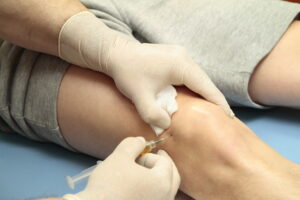
Stem cell therapy is a non-surgical treatment, considered the most advanced regenerative medicine for treating sports-related injuries.
This type of therapy is highly effective for relieving painful symptoms and increasing the range of motion and mobility. Unlike other treatment options, sport medicine stem cell treatment is minimally invasive and requires much less rehabilitation time.
The therapy is effective for both acute and chronic traumas and disorders of the musculoskeletal system, and offers several benefits for injuries from activities, like:
Promoting faster healing and recovery from the injury.
Reducing and preventing inflammation.
Regenerating damaged tissues.
Improving athletic performance.
Stem cell’s potential to heal and regenerate into any body tissue makes them an ideal treatment for a variety of sports-related health conditions, including:
Achilles tendonitis
Shin splints
Sprains and strains
ACL tear
Tennis elbow
Runner’s knee
Let’s learn more about stem cell therapy for athletes, its potential for treating sports injuries and its role in preventing these kinds of physical trauma.
Stem cells and their role in treating diseases
Stem cells are primal cells, found in every living organism, with the potential to make new tissues and organs and treat several types of diseases. They are the body’s raw material with the unique ability to differentiate into any specialized cell, muscle, or tissue they are injected into. Their anti-inflammatory, immunomodulatory, self-renewing, and regenerative properties make them the perfect medicine for a variety of neurodegenerative diseases, strokes, and sports injuries.
Stem cells can be harvested from the patient’s bone marrow, or adipose tissue and reinjected into the injury site after separation through a ‘density gradient technique’, to obtain a stem cell-rich solution. Ready-made cell products from donor material are also used in clinics.
Stem cell therapy athletes treatment programs offer novel alternatives to many surgical procedures. According to many past and ongoing pieces of research, cell-based therapy:
reduces inflammation;
repairs and regenerates any damaged or injured tissues;
releases growth hormones to promote natural healing for long-lasting results.
Mesenchymal (adult) stem cells are widely used for regenerative medicine therapies across sports medicine due to their multipotency, low immunogenicity, and no ethical concerns. MSCs are ideal for athletic performance improvement, trauma prevention, and rehabilitation.
How stem cells can be used in sports?
Athletes and doctors frequently use stem cell interventions and therapies to address sports-related injuries. These cells can not only treat severe bodily injuries but also prevent them by repairing the muscles, tendons, or joints under continuous physical stress. When injected into the damaged tissues, stem cells repair the body and add strength over time (DOI: 10.1007/5584_2018_298). Their non-surgical and short recovery periods make them the perfect choice for people with active lifestyles.
Stem cell therapy for injury prevention in sports
As a regenerative medicine approach, stem cell therapy is most popular among sports organizations for preventing trauma, maintaining strength, and prolonging an athlete’s career. Most players have their stem cells harvested and banked for future use. These banked stem cells under the right conditions can be grown in large numbers to maintain supply throughout the season.
As athletes experience continuous physical stress during the sport, stem cells can be utilized to heal, repair, and strengthen the damaged or swollen tissues and muscles within the body. By ensuring the damage remains controlled during activities, the likelihood of catastrophic injury goes down considerably.
Athletes using stem cell therapy for injury prevention and healing properties are not subject to any legal consequences because it may not affect how well an athlete performs.
When treating a sports-related injury, why are stem cells so beneficial?
Although stem cell therapy is a non-traditional approach to preventing and treating sports-related injuries, the treatment is desirable due to its many benefits, which include:
Swift and effective healing
Lengthy recovery is the most critical issue with most conventional treatments. Cell-based therapy reduces the recovery time, allowing athletes to get back on track as soon as possible. In some conditions, it hardly takes more than a week for patients to recover and gain their strength back depending upon the treatment procedure.
Reduces inflammation
The regenerative approach is highly effective for inflammation as well. Besides reducing inflammation, it also alleviates excruciating pain. The effect of the therapy is quite noticeable within a few days or weeks of the treatment, especially anti-inflammatory effects that can last for a long time.
Tissue regeneration
Some sports injuries can result in serious tissue damage leading to permanent effects. Stem cells can heal and regenerate these damaged tissues (muscles, joints, etc.) through their multipotency and self-renewal capabilities. The most frequent injuries among athletes, like ripped tendons and cartilage damage, may require stem cell tissue regeneration abilities to heal.
Athletes who have undergone stem cell therapy?
The cell-based approach is quite popular among athletes and sportsmen. Here’s a list of athletes that have gotten stem cell treatment for their sports-related injuries:
Jarvis Green
Knowshon Moreno
Sidney Rice
Hines Ward
Adrian Clayborn
Ronaldo McClain
Alex Rodriguez
Josh Hamilton
Conclusion
With the advent of stem cell research, a lot of traditional surgeries have now been replaced by stem cell therapies. For many cases of sports injuries, it is a preferred treatment choice due to its therapeutic benefits and quick recovery of the patient.
This approach has helped many athletes overcome the condition and return to their sports careers. It can also help other people who have experienced physical trauma to improve their symptoms.
Read more:
Could Stem Cells Be Useful for Sports Medicine?






